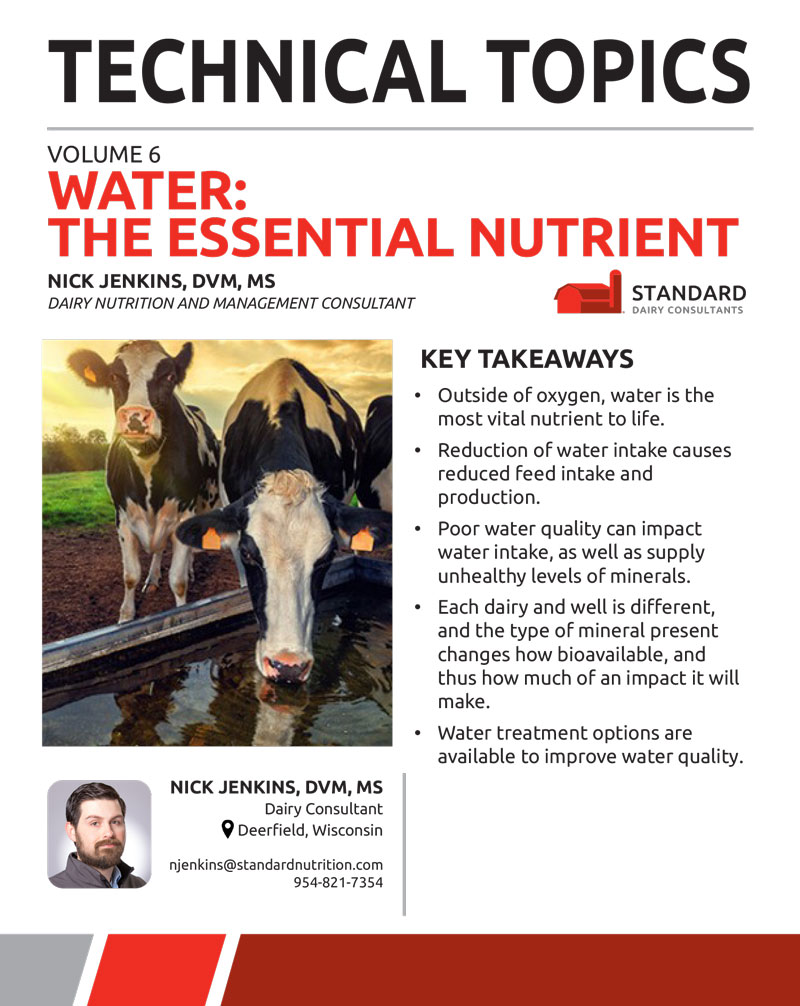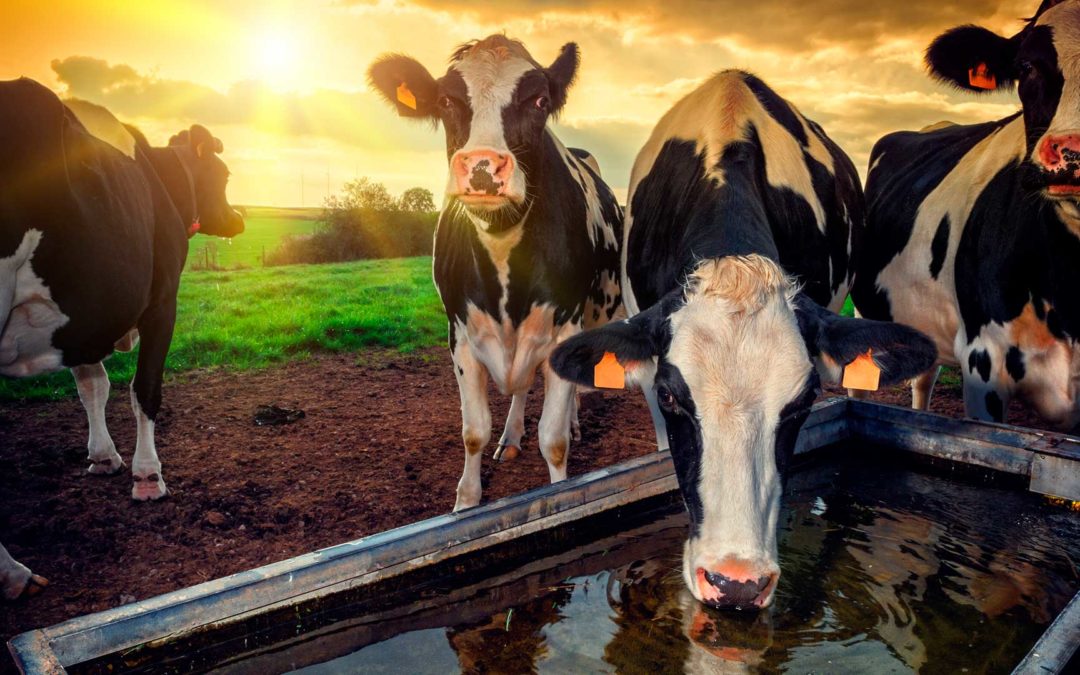Written by: Nick Jenkins, DVM, MS
KEY TAKEAWAYS IN THIS ISSUE OF TECHNICAL TOPICS:
- Outside of oxygen, water is the most vital nutrient to life.
- Reduction of water intake causes reduced feed intake and production.
- Poor water quality can impact water intake, as well as supply unhealthy levels of minerals.
- Each dairy and well is different, and the type of mineral present changes how bioavailable, and thus how much of an impact it will make.
- Water treatment options are available to improve water quality.

Water is the primary component of cells, tissues, and organs; water is a solvent, reaction medium, reactant, building material, lubricant, carrier of nutrients and waste products, thermoregulator, and shock absorbent. Outside of oxygen, water is the most important ingredient for life. However, we very rarely know the quality or quantity of water that livestock is consuming. Water makes up nearly 70% of the total body weight of a mature cow and milk is about 87% water. To put that in context, a 1600 lb. cow milking 90 lbs. per day is composed of between 114 and 143 gallons of water. As you would expect, given the importance of water to the dairy cow, restriction of water results in a rapid reduction of DMI and milk yield. While restricting water causes obvious detriment, we are often unaware of the effect caused by transient restrictions on water availability or quality on cattle.
FREE WATER INTAKE
Free water intake (FWI) is the water that an animal voluntarily consumes directly from a water source, as opposed to the total water intake which would consider the moisture content of feeds. There have been many attempts to estimate the amount of water consumed by dairy cattle and there are several variables that play a role such as DMI, ration moisture, Sodium and Potassium levels, milk production, environmental temperature, day of the year, ash content of the ration, body weight, crude protein, and concentrate percentage in the diet. Estimates can vary between formulas, but a mature mid-lactation cow milking 85lbs per day consumes between 25-35 gallons of water per day. As the temperature increase, FWI increases about a half-gallon for every 2-degree increase, greatly increasing the water requirement during the summer months. The following table provides an example of the FWI of dairy cattle with variable production and environmental inputs.
Finding out how much cows are drinking compared to the estimate is useful in determining if there is something limiting FWI, which will directly or indirectly impact performance. While poor water quality can reduce FWI, other factors should also be considered such as lack of access, overcrowding, poor health, lameness, etc.
Unfortunately, estimates of the water intake of dry cows and calves are limited. Furthermore, seeing the effects of marginal water intake or quality is much more difficult to discern. In general, calves need more water compared to adults. A rough estimate of 4:1 (pounds of water: pounds of DMI) can be used, but calves should always have free choice access to clean water.
WATER QUALITY
Water for livestock has less stringent requirements than those for humans, but similar subjective assessments of water quality can be applied. Water should be clear, colorless, odorless, and palatable. Water supplied to cattle should also be low in total solids and not contain pollution or microorganisms.
Analysis of water quality focuses mostly on minerals and metals. To truly understand the effect of elements present in the water, the speciation, or the form that element is found in, must be known. The form greatly effects whether the element is bioavailable. Generally, water will not make a meaningful contribution to the macromineral intake of a dairy cow (0-10% of required), although water that is at the upper end of what is considered safe can sometimes supply more of a mineral than is required. This becomes particularly problematic when dealing with balancing for DCAD levels. Both negative DCAD pre-fresh diets and positive DCAD lactating diets can be affected if levels of anions or cations in the water are high.
Toxic levels of most minerals have been established, however, the effects are often unknown because of a lack of research and recommendations across species. The most likely minerals to be seen at toxic levels are sulfur, sodium, iron, magnesium, selenium, and fluoride.
Total Dissolved Solid (TDS) is an estimate of the inorganic constituents dissolved in a sample of water and is used as the first indicator of water quality. The following table adapted from NRC, 2001 provides a guideline for understanding when TDS are problematic for dairy cattle.
Drinking water can also contain elevated levels of microbes that can have a negative effect on animal performance. Analyses of bacteria performed on the water are often unspecific and do not determine if the bacteria present are pathologic and are unable to evaluate the presence of other bacteria, viruses, protozoa, etc. Studies on this topic have shown that metal water troughs have a lower coliform count than concrete or plastic troughs. While sunlight is known to be a great disinfectant, it is important not to place water troughs in direct sunlight, as it will increase water temperature and reduce the FWI of cattle.
WATER TREATMENT
If the water in your dairy is sub-optimal, there are several treatment methods available to improve water quality. The main difference in water treatment methods is whether a physical or chemical method is utilized. Physical methods, such as reverse osmosis, work by filtering water through a membrane, which removes most inorganic compounds as well as other organic contaminants, pesticides, unpalatable or odiferous chemicals, etc. A cation or anion exchange system is a chemical method that passes the water over beads that are saturated with Sodium or Chloride. These minerals are exchanged for others such as Magnesium and Calcium in cation exchange, and nitrate and sulfate for anion exchange. Oxidation is a process that can remove Iron and Manganese by converting these metals to a precipitate, which can then be physically filtered from the water.
CONCLUSION
While water is vital to life and is a key constituent of milk, we often forget about the impact that altered water quality and intake have on dairy cattle. Research and common sense prove the profound effect that restricting water intake or providing poor-quality water has on production and health. We know much less about the effect of marginal quality or intake, and less still about the interaction with the variety of management and feed-related factors we all deal with daily. Most dairies will not have problems related to water, but when situations arise that “just don’t add up”, or cows are not responding to management or nutritional changes as we expect, water should be something that we have on our list to evaluate and understand how it may be affecting the cows.
Discussing the role of individual minerals on individual dairies should be reserved for conversations with your nutritionist and/or veterinarian and can’t be covered adequately in this newsletter, but the first step in those conversations is getting a water sample. Contact your Standard Dairy Consultant who can submit a complimentary sample on your behalf.


